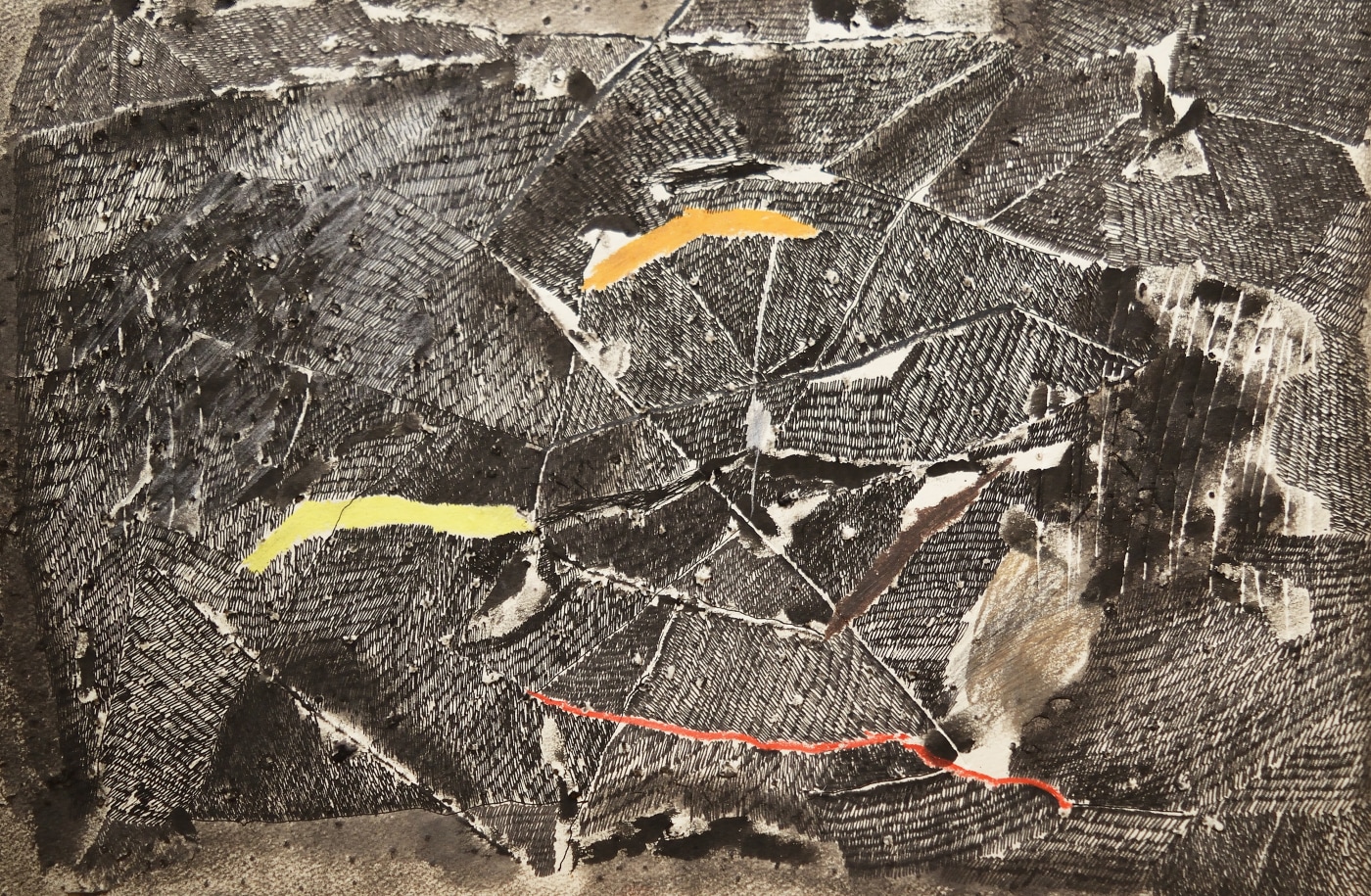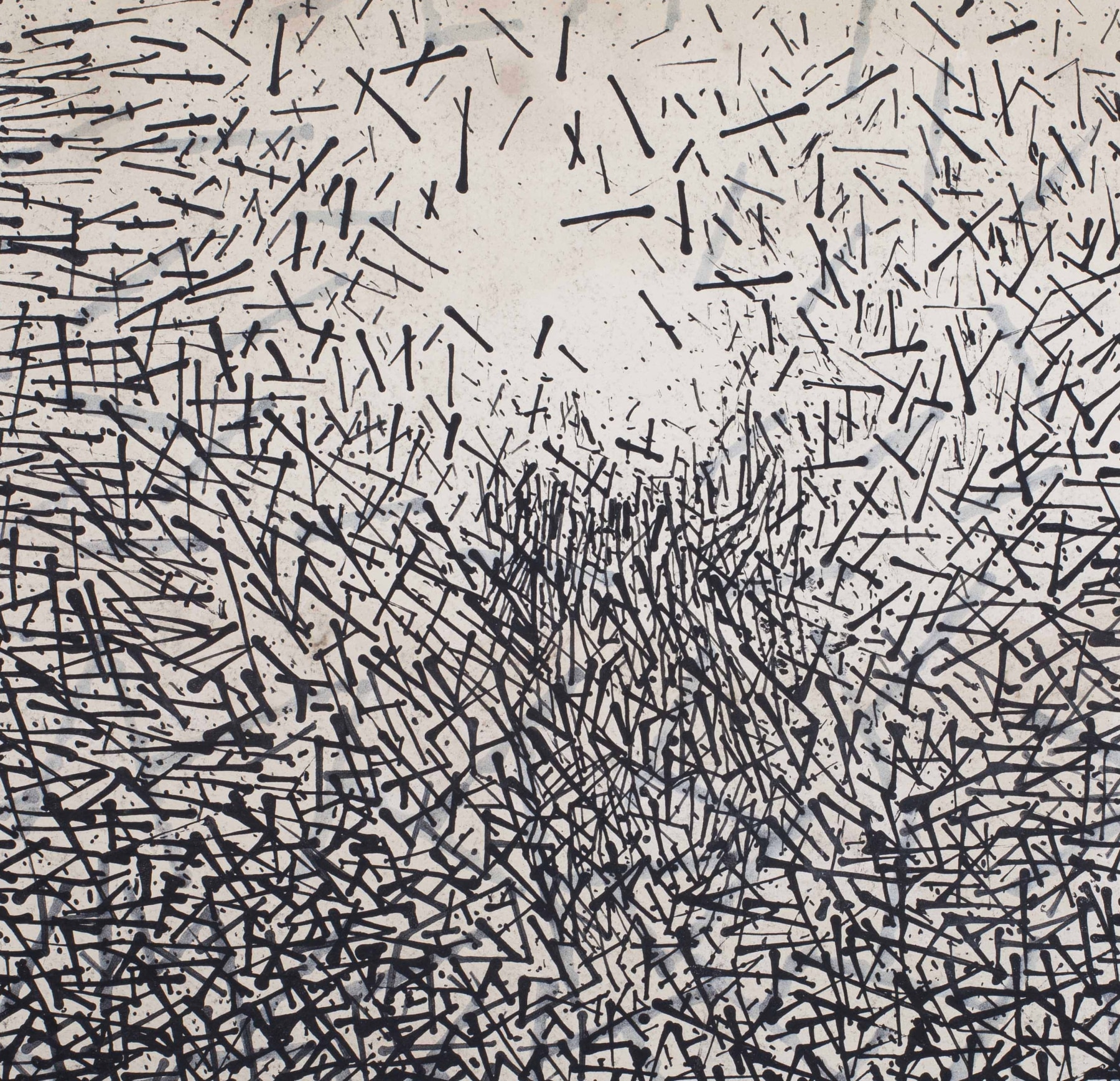

Untitled, 1975 | Ink, pastel and graphite on paper | 13″ x 17″ (detail)
Arpita Singh has long been celebrated for the large, figurative paintings - vibrantly colorful and iconographically dense, these works gesture towards mythology and folklore, while drawing on the expressiveness of the line and textures evolved and developed during her seminal period of 1973-82. Singular in their allusion to contemporary Indian life, Singh’s works forge a unique visual vocabulary and narrative sensibility that have had major influence on the generations of artists who have followed her.
The 1973-82 period with predominantly abstract compositions on paper, principally reliant on line and primarily monochromatic—lay the formal foundations of Singh’s oeuvre and create an aesthetic bridge to her later and better known works. It reveals both a serious curiosity about line, depth and space, and a playful improvisation—a willingness to suspend certainty in the search for new. These tendencies continue into and indeed sustain Singh’s till today.
“Images in which the comic and the tragic seem interchangeable, are characteristic of work that has made Ms. Singh one of the best-known contemporary artists in India. They are also evidence of an art gradually darkening in tone and lightening in form, a rewarding way to go in this remarkable painter's hands.”
The New York Times
A dreamlike logic liberates familiar, everyday objects from the rules of reality, transforming them into symbols which evade interpretation... Arpita Singh’s paintings further capture the tenuous line separating an ever-shifting landscape and the sanctum of home. They consider whether the home can remain a refuge, immune from the surrounding disturbances, the landscapes in motion. Collectively, however, these works demonstrate that life must continue despite and within these contested terrains.
Shanay Jhaveri
“There was a desire to put colours at times and I used them sparingly so that I remain in touch with them...
and gradually as I started associating forms with recognisable things, narratives followed, and then
the move back to figurative.”
Arpita Singh

Untitled, 1980 | Poster paint on paper | 22.5″ x 26.75″ (detail)
Always remaining attentive and focused, the artist works her way across the paper, line by line, and dot by dot. The drawings are her way of marking and shaping time….There is something relentless about the way she goes at it — mark-making without devolving into a signature gesture or flourish. One feels that she continually refuses the comforts provided by a style. The results are astonishing.
John Yau, Hyperallergic
"Arpita Singh achieves a richness in suggestion through the repetition of images as multiple reflections or as a system of inner rhymes so the self-same motifs in different positions or different relationships take on a different connotation..."
EBRAHIM ALKAZI
“Singh, who thinks of herself as a detached observer of the grand spectacle of life has shown in her art a driving urge to understand reality and the intangible rhythms that lie behind giving it shape and substance.”
ELLA DATTA
"Sometimes stained or slightly battered, the drawings show their age proudly. This is art, after all, that survived the intensity of its own turbulent making."
BARRY SCHWABSKY

Arpita Singh was born in 1937 in West Bengal, India, and moved with her family to Delhi in 1946, where she has since lived and worked. She attended School of Art, Delhi Polytechnic, and after graduating, she worked as a textile designer at the Weaver’s Service Centre, part of the Handloom Board of India.
Arpita Singh’s work has been featured in exhibitions around the world, including The Barbican Centre, London; MPlus Museum, Hong Kong; Pompidou Centre, Paris; Mori Art Museum, Tokyo, Japan; Guggenheim Bilbao Museum, Spain; The Serpentine Gallery, London; Museo Nacional de Centro Reina Sofia, Madrid, Spain; Museum of Fine Arts (MFA), Boston, MA; Kiran Nadar Museum of Art (KNMA), New Delhi; Modern Art Museum, Fort Worth, TX; Fukuoka Asian Art Museum, Japan; Kunstmuseum Bern, Switzerland; Royal Academy of Arts, London; Peabody Essex Museum, Salem, MA; Turner Contemporary, England; Asia Society, New York; The Art Gallery of New South Wales (AGNSW), Sydney, Australia and The Serpentine Gallery, London, UK.